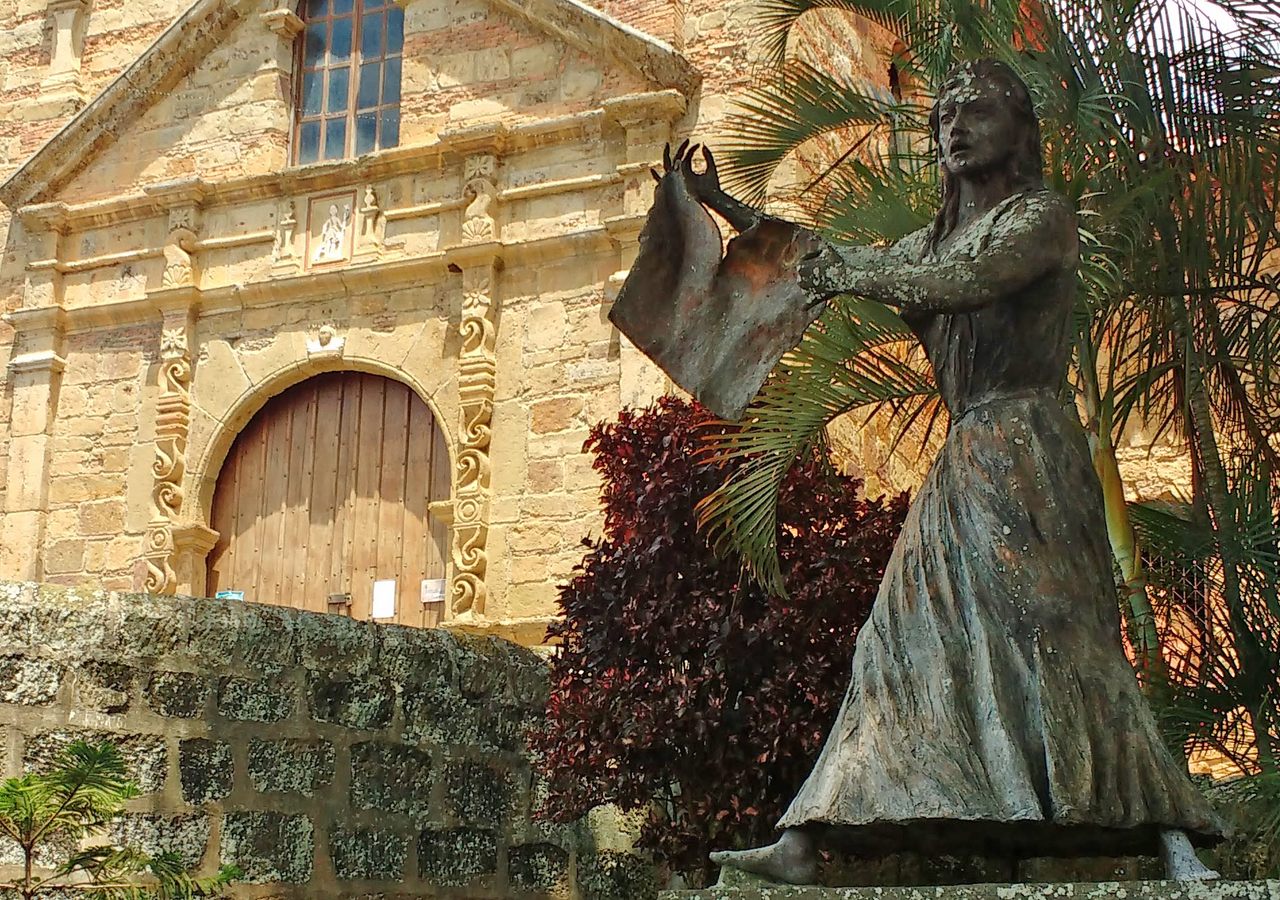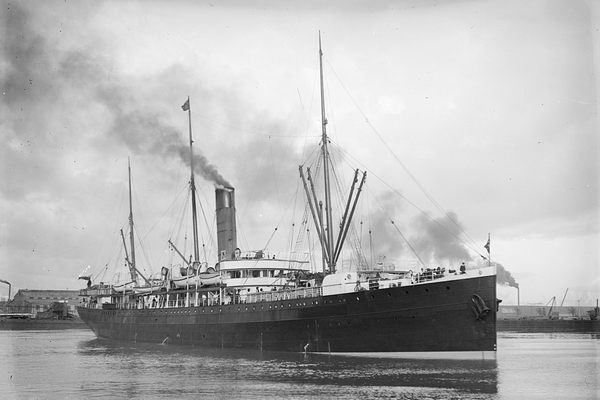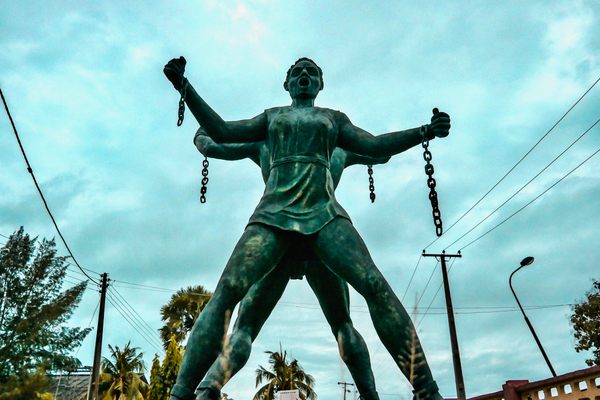Manuela Beltrán Is a Colombian Hero. What If She Never Existed?
Historians have found little evidence of the revolutionary icon.
Every revolution needs a hero, and Manuela Beltrán was the most unlikely of them all. A peasant town merchant with the rare skill of literacy, Beltrán would become a pivotal figure in the Colombian Comuneros Revolt of 1781. Today the country is filled with statues honoring her story: After Spanish authorities declared a new tax spike in Socorro, her hometown in the northeast, Beltrán marched to the town square, tore up the edict, and led a revolution that would pave the way for independence. Generations grew up hearing about her exceptionalism. Schools and neighborhoods all around the country are named after her. In 2011, the government printed a stamp with her image. She inspired a telenovela and the creation of the University Manuela Beltrán in Bogotá. She is the earliest member of a small and elite sorority of women revered for their roles in the revolts for independence—Colombia’s revolutionary martyrs. Or so we thought.
Enter Judith González-Eraso.
“These women were echoes of fantasy.” A fast-talking feminist whose middle name is, incidentally, “Colombia,” González-Eraso is a doctoral candidate in sociology at Facultad Latinoamericana de Ciencias Sociales in Ecuador, and a researcher and former professor at the Universidad del Valle in Colombia. She has spent 12 years studying the women of the country’s independence movement. Again and again, she faced a disconcerting truth: The evidence simply didn’t support the stories. The first mention of “Manuela Beltrán,” as a revolutionary figure doesn’t appear until an 1880 historical text, over a century after she allegedly lived. There aren’t any traces of the many quotes assigned to her or her contemporary heroines—no headstones or death certificates and little to no record of their names.

“I am not denying the participation of women,” says the historian. But the story of Manuela Beltrán as a hero and revolt leader is almost certainly only that—a story. A native of a working-class neighborhood in Cali that is now named, yes, Manuela Beltrán, Gonzalez-Eraso is both a daughter and a challenger of Colombia’s feminist historical canon.
“Manuela” and “Beltrán” were common names in the revolutionary period. A genealogist found a baptism record of one Manuela Beltrán born in 1724. But Gonzalez-Eraso says genealogists’ job is to find a name, not to check the narrative. She did check the narrative, and believes the connection between the myth and the name is speculation. There are also three different Manuela Beltráns who had children between 1760 and 1780, and yet another Manuela Beltrán married in 1779. These are only the ones in the region. (Aside from church-held baptism and marriage certificates, records from that time are thin at best.) Some of these records match the stories that say Manuela Beltrán was young (and beautiful?); others match the ones claiming she was an old woman. And none match the plaque in front of the statue at the Manuela Beltrán University in Bogotá, which claims that Beltrán was an “intrepid, brave, visionary, idealistic and patriotic leader born in 1722.”
What does exist is a transcription of a 1782 document where the mayor of Socorro writes that a “woman led by a few men tore up the table containing the regulations for the establishment.” He continues, “I only knew the Manuela Beltrán who broke the edict, I did not distinguish any other subjects, because all those who showed up took precautions with their crooked hats.” This is the only known documentation from the time of the events. No record exists of what most historians would start claiming a century later: that she led a revolution; that she screamed “Long live the king, down with bad government!”; that she owned a store in the main square; or that she was a hero of the proto-independence movement.

In March 2023 a headline appeared in El Espectador, a reputable Colombian newspaper: “Manuela Beltrán, the Heroine that Never Existed.” “Manuela Beltrán is a product of literary fiction,” said Armando Martinez, the president of the Colombian Academy of History and the former director of the General Archive, who was all over the news claiming Beltrán was an invention of two late 19th-century romantic novelists. He says these authors falsely presented the 1781 revolt as a precursor to the 1810 independence and added that it was another woman, Antonia Vargas, who tore down the edict. (Martinez failed to mention he was a reviewer of González-Eraso’s master thesis, which first laid out the myth of Beltrán and was published as a book in 2018.)
The claims touched a nerve. To face the likelihood that Manuela Beltrán is a fantasy amounts to an earthquake to the country’s history. Since the news broke, Colombians have had all sorts of reactions: from outrage to doubt, disbelief, and frustration. The newspaper El País said it was an attempt to erase her from the history books. Like El País, many have latched onto the 1724 baptism record, assuming that because a Manuela Beltrán existed then the Manuela Beltrán existed. Johanna Salamanca, a recent graduate of the now ill-named Manuela Beltrán University, thinks “it’s logical, but somehow sad.” She compares Beltrán with Jesus—he might have been many men and many stories, but assigning all to a single martyr maintains the myth. Mauricio Durán, a restaurateur in Socorro, fears the cultural repercussions: “If they say she didn’t exist it’s like taking away a slice of the town’s history. I don’t agree with them coming here with these rumors. She’s an icon [here].”
“It’s likely that some things happened and others didn’t,” says historian Jorge Orlando Melo, former director of the Luis Ángel Arango library and author of numerous books on the history of Colombia. Melo offers something in between “she is a fantasy” and “she is our hero.” He believes that, while the woman might have existed, the connection between her gesture of discontent and the fight for independence is a stretch. “I don’t think there’s a doubt that a woman pulled the poster, [a woman] who the mayor of the town calls Manuela Beltrán, and that a Manuela Beltrán did exist. Now, to say that she was a heroine who was fighting for independence––that’s imaginary.”
How did the heroic story take hold? In the late 1800s, what is now Colombia was barely half a century old. Following independence, the country changed its name and geography multiple times: it was the Gran Colombia, the Republic of New Granada, the Granadine Confederation, and the United States of Colombia. It lost Venezuela, Ecuador, Peru, parts of Brazil and Costa Rica. González-Eraso thinks the story of Beltrán helped unite a new, delicate country: “No nation is built out of nothing; the nation required this mythic and civic configuration. We were separating ourselves from Spain; we needed our own symbols and myths.” González-Eraso insists she isn’t trying to rewrite history. But she wants people to recognize heroes are symbolic creations, the product of collective imagination and historical narratives.
Historians agree it’s possible, even likely, that other national anecdotes are legends, too. This story illuminates the enduring power of myths and the need for symbols of rebellion. But it’s also a story about half-truths and exaggerations. Manuela Beltrán still resonates with many who see her as a representative of the country’s fight for freedom. After all, brave women did exist—and maybe all you need to be a hero is someone thinking you are one. People believe in Manuela Beltrán because they want to, and that bears its own kind of truth.


















Follow us on Twitter to get the latest on the world's hidden wonders.
Like us on Facebook to get the latest on the world's hidden wonders.
Follow us on Twitter Like us on Facebook